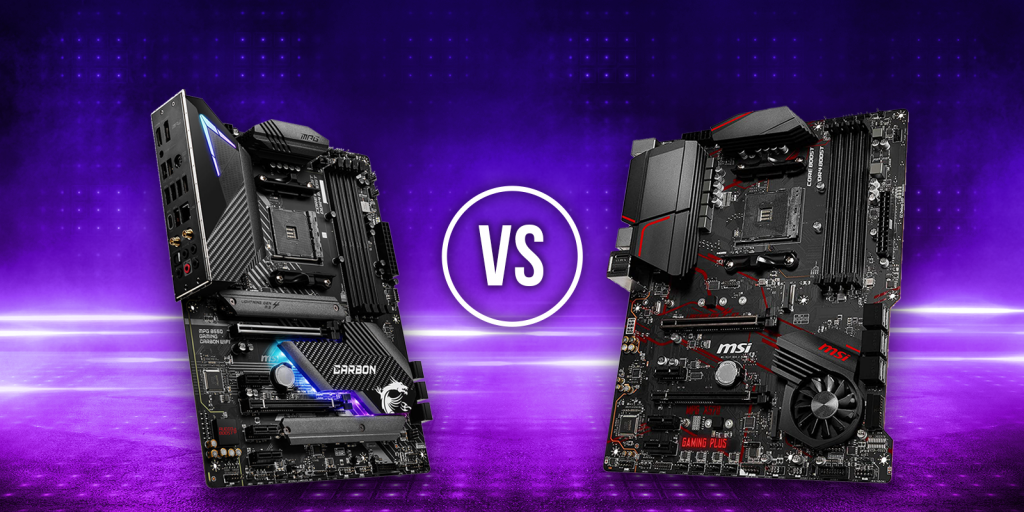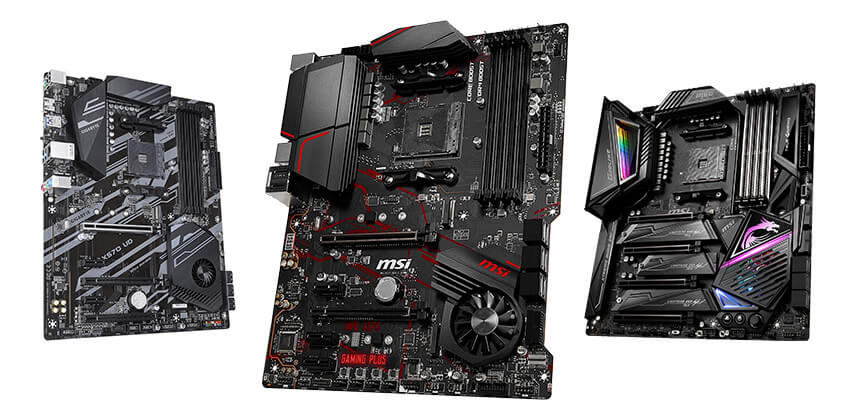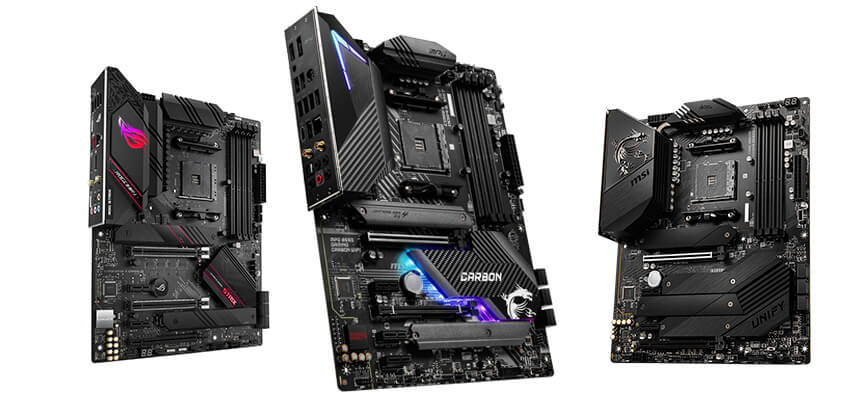B550 Vs X570 Motherboards
This form is protected by reCAPTCHA - the Google Privacy Policy and Terms of Service apply.
Don't have an account?
Creating an account has many benefits: check out faster, keep more than one address, track orders and more.
Gaming is an exciting scene. Not just because of the fast-paced, adrenaline-pumping games but also the new technologies involved. After a long wait, the B550 motherboards, which are an upgrade from the B450, were released, much to PC gamers' excitement.
But that comes with numerous questions because the B550 boards close out the gap on X570 motherboards. Gamers are now left wondering which board is best suited for their needs as manufacturers push the limits of the new motherboards.
If you've been wondering which of the two boards is better or which one you should buy, you're at the right place.

X570 Chipset
The best place to start is by understanding what comprises each of the motherboards and what they are capable of.
The X570 motherboard series was launched in 2019 to replace the X470. It was the first chipset to support PCIe 4.0 based graphics and also NVMe storage devices.
Some general specifications of the X570 series include:
| Direct CPU PCIe Support for GPU | x16 PCIe 4.0 |
| Direct CPU PCIe Configuration | 1 x16 or 2 x8 |
| CPU to Chipset Downlink | x4 PCIe 4.0 |
| General Purpose PCIe Lanes from Chipset | PCIe 4.0 |
| No. of PCIe 4.0 Lanes from Chipset | 16 |
| No. of PCIe 3.0 Lanes from Chipset | 0 |
| Chipset SuperSpeed USB 10Gbps Ports (USB 3.2 Gen 2×1) | 8 |
| Chipset SuperSpeed USB 5Gbps Ports (USB 3.2 Gen 1×1) | 0 |
| Chipset HiSpeed USB 480Mbps Ports (USB 2.0) | 4 |
| Max Possible Chipset I/O | 16 PCIe 4.0, 12 SATA III (6Gbps), 12 USB (8x10Gbps and 4x480Mbps) |
| Overclocking Support | Yes |
| Dual Graphics Card Support | Yes |
| CPU Support | AMD Ryzen 2000, 3000 and 5000 |
The design of the X570 targets high-end gaming and content creation for serious and professional gamers. This series of motherboards can also handle photo and video content processing and editing.
The X570 has AMD's AM4 socket CPUs. If you have any previous generation Ryzen processors, you can continue using them on this platform, but it can't work with the first generation Ryzen 1000 series CPU.
The X570 board can draw anywhere between 11-15W of power depending on the number of PCIe 4.0 lanes. Compared to the previous generation X470, which had a power draw of 6W, this is significantly higher. Hence the X570 motherboards come with a dedicated cooling fan to keep the chipset from overheating.

B550 Motherboard
The B550 motherboard is more recent. It was released in June of 2020. Price-wise, the B550 is less expensive than the X570, and it serves as a replacement for the B450. The B550 motherboard is designed to work with the Zen 3 Ryzen 5000 series CPUs on an AM4 socket. It also supports Zen 2 Ryzen 3000 and Ryzen 4000 APUs.
The main features of the B550 boards include:
| Direct CPU PCIe Support for GPU | x16 PCIe 4.0 |
| Direct CPU PCIe Configuration | 1 x16 or 2 x8 |
| CPU to Chipset Downlink | x4 PCIe 3.0 |
| General Purpose PCIe Lanes from Chipset | PCIe 3.0 |
| No. of PCIe 4.0 Lanes from Chipset | 0 |
| No. of PCIe 3.0 Lanes from Chipset | 10 |
| Chipset SuperSpeed USB 10Gbps Ports (USB 3.2 Gen 2×1) | 2 |
| Chipset SuperSpeed USB 5Gbps Ports (USB 3.2 Gen 1×1) | 2 |
| Chipset HiSpeed USB 480Mbps Ports (USB 2.0) | 6 |
| Max Possible Chipset I/O | 10 PCIe 3.0, 6 SATA III (6Gbps), 10 USB (2x10Gbps, 2x5Gbps, and 6x480Mbps) |
| Overclocking Support | Yes |
| Dual Graphics Card Support | Yes |
| CPU Support | AMD Ryzen 3000 and 5000 |
The B550 doesn’t have PCIe 4.0 lanes. Instead, the CPU and the motherboard link is through PCIe 3.0x4 lanes. But if the CPU has direct PCIe 4.0 lanes for graphics and NVMe storage, then the B550 motherboards can be designed with that in mind.
Although the B550 is often marketed as an entry-level motherboard, it is also aimed at high-end gamers, professional photo and video applications and content creators.
With the exception of the PCIe 4.0 lanes, the B550 has all the other bells and whistles that the X570 has.
The B550 motherboard can work with the Zen 3 based Ryzen 5000 series and Ryzen 3000 series CPUs. The motherboard has a power draw of 6W. Therefore it doesn't need to have any dedicated cooling fans for the chipset.

Differences Between B550 and X570 Motherboards
Compatibility
Among the first notable differences between B550 and X570 motherboards is compatibility with different CPUs. Not all motherboards are going to support all types of CPUs, which makes compatibility a big issue.
The B550 chipset has relatively good compatibility. The motherboard is compatible with Ryzen 3000 CPUs and above. The motherboard will also support the Ryzen 5000 series, but it doesn’t support Gen 1 and Gen 2 CPUs from Ryzen.
The B550 motherboards also don't have APUs that come under the Ryzen 3000 series, which is another important factor you should consider.
X570 motherboards don’t have any issues with the compatibility of the APU. They are also compatible with the Gen 2 CPUs, which are processors in the Ryzen 2000 series. However, these boards are limited to the Ryzen Gen 3 CPUs, unlike the B550, which is more versatile.
If you're looking for a CPU beyond the Ryzen Gen 3 CPU, then the B550 motherboard is what you should go for. If the CPU is Gen 3 or Gen 2, you can go with the X570.
PCIe 4.0 Support
PCIe 4.0 interface on your motherboard can make a lot of difference. It facilitates higher data transfer speeds from GPU, SSDs and other expansion cards.
The presence of PCIe 4.0 means you can have a max bandwidth of 16 GT/s per lane instead of the usual 8 GT/s you get from a PCIe 3.0 interface. The former gives you the additional advantage of getting extra lanes for extra SSD slots.
The B550 and X570 motherboards have different support in terms of PCIe. The B550 motherboards connect the processor using the 4-lane PCIe 3.0 connection, while the X570 chipset has a PCIe 4.0.
The B550 doesn’t have any PCIe 4.0 lanes. But the X570 has an additional 16 PCIe 4.0 x 16 lanes. However, the B550 boards have PCIe 4.0 connectivity that works on the CPU directly using the primary PCIex16 and also the M.2 slots. B550 boards can use PCIe 4.0 for two devices, which is a huge upgrade from the B450 boards.
The X570 boards support dual PCIe 4.0 M.2 slots. Although the B550 can also support multiple slots, only one is supported by PCIe 4.0.
Overclocking and Performance
Both motherboards support RAM and CPU overclocking. But the VRMs on the X570 are better in delivering stability compared to the B550 motherboards. Overall, you can expect better overclocking and performance from X570 motherboards.
Dual GPU Support
If you're thinking of configuring a dual GPU in your build, it's important for the motherboard and CPU to support Nvidia's SLI or AMD's crossfire. Luckily, both the B550 and the X570 support these features. But in the case of the B550 motherboards, you will only find this feature on the premium and high-end options.
Connectivity
The difference in the number of PCIe 4.0 on either board also means there is a difference in connectivity.
The X570 has 8 more USB 3.0 ports than the B550 and a more reasonable number of storage options. It offers an additional 8 SATA ports, which can be reconfigured. For gamers who want the fastest connection and the most diverse storage solutions, the X570 board is a better and more advanced option.
VRM Power Phases
The role of the VRM in the motherboard is to maintain stability in power delivery to the CPU for the best processor health and get the most utilisation out of the maximum potential of the CPU.
Generally, the more the VRMs, the better. A board with more VRMs will have better control over the power delivered, and the VRMs also lessen the load on each other.
The X570 has a higher number of VRMs, which allow the board better overclocking of powerful processors while maintaining stability. The B550 has fewer VRMs which limits the motherboard to how much extra juice it can squeeze out of powerful processors. In terms of VRMs, the X570 has a clear edge over the B550.
Built-in Cooling
Cooling is a critical part of building a durable gaming rig. But the addition of built-in cooling is not standard. It varies depending on the amount of power the chipset draws and hence the production of heat and the need to dissipate that heat.
The X570 chipsets draw between 11-15W of power which requires the board to have a built-in fan to keep the chipset cool. Almost all X570 boards have a small built-in fan to keep the board cool.
The B550 boards, on the other hand, draw about 6W of power. It's not enough to warrant a dedicated chipset fan because of the lower power consumption and heat generation. It's not impossible to find a B550 board with built-in cooling, but it is uncommon because the majority of the boards don't necessarily require it.
Price
When weighing between the two options, price is going to have a substantial influence on your buying decision.
X570 boards have more premium options and more extensive features. Therefore, you should expect to pay more to land the X570 boards compared to the more basic B550.
If you want to build a rig using a high-end processor like the Ryzen 9, the X570 chipset is a perfect choice. But if it’s a mid to low-level processor, it is more practical to go with the B550.
X570 Vs. B550: Which Is Better?
Technically, the X570 motherboard is better than the B550. It has better and more features. However, in terms of mass appeal, the B550 seems to be attracting and receiving a lot more attention. The B550 is ideal for any average build, which is where there is a larger market share.
The X570, though consisting of various fancy features, won't give you a substantial advantage on any build unless you focus on building a high-end rig for gaming or video editing, which is when you can utilise all the incredible features of this powerful board.
Is X570 more Future Proof than B550?
You could say the X570 is more future-proof than the B550 based on the technical aspect, but that is not necessarily the case.
The B550 and the X570 have the same lifespan in terms of future CPU compatibility. Both chipsets only support up to Zen 3 Ryzen 5000. Most CPUs beyond that will require a new motherboard, particularly one with the AM5 socket.
However, the X570 boards have been more favoured in terms of future-proofing because they have more PCIe 4.0 slots compared to B550, which means they can support multiple PCIe Gen 4. But this only matters to users who find this feature important.
Benefits of X570 and B550
| B550 Motherboard Pros | X570 Motherboard Pros |
| Some models offer better VRMs for the same or less cost | Can support multiple PCIe 4.0 M.2 SSDs |
| Some boards have better networking features for less | Can offer multiple PCIe 4.0 expansion slots |
| Only practical choice if you want a smaller mATX motherboards. X570 has a few microATX models. | Have more USB 3.2 Gen 2 ports overall |
| Provide a cheaper way to get an internal frontal USB Type-C header for some cases with a front USB C port. | Are the only real option for 8 or more SATA ports |
| There is no chipset fan on board, so no noise coming from the board or future costs of replacing the fan. | More PCIe 4.0 lanes for faster overall connectivity |
| Best multi-GPU support | |
| Supports Ryzen 3000 APUs | |
| Supports Ryzen 2000 CPUs | |
| Deliver extreme 5G and 10G LAN ports | |
| Perfect for overclocking powerful CPUs and RAM |
Final Thoughts
It is clear that while the X570 and the B550 motherboards have advantages and disadvantages, there is no clear winner on which is best. The better option differs case by case depending on the needs of the user and the purpose of the build.
In instances where performance is critical, and the goal is to create a high-end rig, X570 motherboards are better suited. But for average rigs with slightly above average performance, the B550 motherboards are a better choice. It is also important to consider other factors, including the processor you intend to use on your rig and budget, both of which will help you determine the best motherboard for you.

